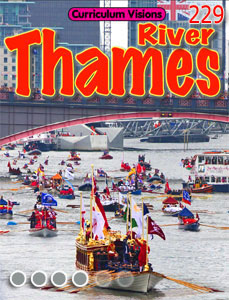The Thames is one of the world’s most famous rivers because of its connection with London. It is often called ‘London’s river’ and ‘The Gateway to London’.
It is quite a modestly-sized river, just 250km/150mi long, draining a part of southern England of just 16,000 sq km (6,200 sq miles).
Most of the rivers that flow into the Thames are even more modest. The biggest tributaries are the Cherwell, Kennet, Lea, Loddon, Medway, Mole, Wey and Windrush. Yet although they are small, they, too have been important in the history of England.
The Thames flows more or less west to east, from the west; where it rises in many springs in the Cotswold Hills, to the estuary east of London where it joins the North Sea.
Along this course, it makes two wide curves, one to go south from Oxford to flow through a gap in the Chiltern Hills at Goring, and another to sweep north again around Henley. In the part near to Oxford it is known as the Isis.
The Thames has been important to the whole of Britain, quite out of proportion to its size. To find out why, you need to look at the landscape of Southern England. If you were to look at the area around London from space, you would see that it is shaped like a basin with a rim made of long lines of hills – the Chilterns and the North Downs. But you don’t often notice this because the river and its branches have cut gaps in all of the hills. So the importance of the Thames is not so much as a river that can carry goods – it is really only navigable as far as London except for small barges – but in the way that the Thames and its tributaries have cut the gaps through the rings of hills that surround it.
The Romans knew this and built their roads outwards from London like the spokes of a wheel, following the tributaries and going through the gaps. The Romans also built forts along the river, such as at Staines (near London) and Dorchester, just south of Oxford. They knew very well that they had to protect their important routes.
The canals and then the railways, and now the main roads and motorways still go through the gaps in the hills used by the Romans.





